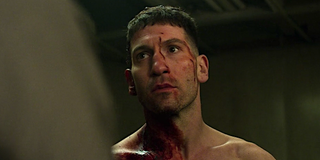Why The Punisher's Violence Had To Be So Realistic, According To The Showrunner

Some spoilers below for Season 1 of Netflix's The Punisher.
Season 1 of Netflix's The Punisher is finally here, and Marvel's TV universe has never been so unflinchingly brutal. Spinning off from the previous most violent MCU TV show, Daredevil, The Punisher puts Frank Castle and the other characters through the wringer when it comes to violent action scenes. When CinemaBlend recently spoke with the drama's creator and showrunner Steven Lightfoot, he shared with me the interesting and understandable reason why he wanted to make sure The Punisher's violence was crafted so realistically.
I thought the guys set a really good bar in Daredevil Season 2, actually, with that fight in the prison and that fight in the diner. I felt they pitched it just right, which was: you should be shocked by it and sort of a little sickened, because I think that's real. My attitude is, it's worse when you see someone get hit in the face with something, and there's not a drop of blood, because it kind of says, 'Oh, that wouldn't hurt.' I think that's worse, personally. I feel like my attitude was, the violence should be real and should have real consequences. In that every time Frank goes out and does something, a little bit more of him is left behind. There's a cost to it. And so that was the philosophy there.
I was quite intrigued by that response, and I wish there was a scientific study right at my fingertips that would perfectly explain whether consequence-laden violence is better or worse for viewers' mental states than the Itchy & Scratchy kind of violence where things are never supposed to reflect reality. I suppose it depends on the intent behind the project, and the audience involved. For instance, when I was a kid, I used to love when Steven Seagal or Jean-Claude Van Damme would break bad guys' legs and arms in ridiculous ways; however, I'm not sure I would have felt quite as jubilant back then if I was watching Frank ruin a dude's knee by slamming a sledgehammer into it. I'd have still liked it, sure, but the cartoonish glee would have given way to grim complacence.
Big comic book movies like The Avengers and Man of Steel can spark conversations about how dulled the life-and-dead stakes and consequences feel, sometimes because all of the main characters feel impossibly perfect, and sometimes because the films don't dive into addressing the millions of people that would have been killed in all of the large-scale destruction that goes on. Nobody goes into The Punisher expecting Frank Castle to get killed, of course, but Steve Lightfoot wants us all to feel the visceral impact of every bruised rib, swollen eye and split-open knuckle. Because while The Punisher certainly employs a bit of glorification of its fisticuffs and gun violence from an aesthetic standpoint, there is no sugarcoating the fact that every character's bad decisions lead to bigger problems, and the deaths and near-deaths in The Punisher have their own ripple effects in the story.
Sure, this lesson of consequences could be taught in many different ways that don't involve characters getting their faces beaten in by their own legs, but this is The Punisher, after all. Frank Castle isn't going to sit his enemies down to put them through thought experiments like the Trolley Problem. He's going to get the information he needs, and then he's going to throw somebody through a wall.
All 13 episodes of The Punisher are now available to stream on Netflix in all their blood-soaked glory, and CinemaBlend will have a lot more exclusive coverage coming in the next week, so stay tuned. When you're done binge-watching this latest Marvel effort, check out some other comic book shows we're looking forward to, and then plan your next binge with our 2017 Netflix schedule and our fall TV premiere schedule.
CINEMABLEND NEWSLETTER
Your Daily Blend of Entertainment News

Nick is a Cajun Country native and an Assistant Managing Editor with a focus on TV and features. His humble origin story with CinemaBlend began all the way back in the pre-streaming era, circa 2009, as a freelancing DVD reviewer and TV recapper. Nick leapfrogged over to the small screen to cover more and more television news and interviews, eventually taking over the section for the current era and covering topics like Yellowstone, The Walking Dead and horror. Born in Louisiana and currently living in Texas — Who Dat Nation over America’s Team all day, all night — Nick spent several years in the hospitality industry, and also worked as a 911 operator. If you ever happened to hear his music or read his comics/short stories, you have his sympathy.
Most Popular






